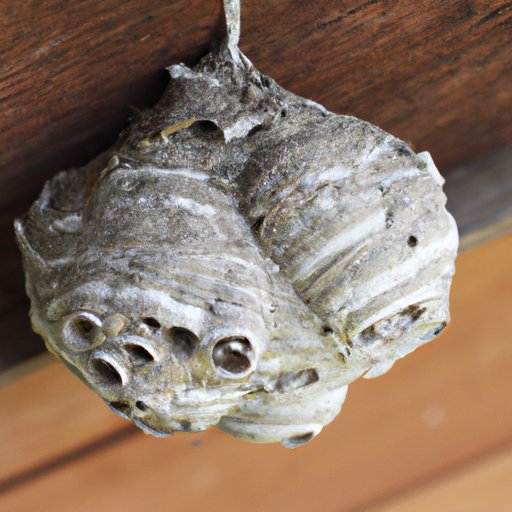I. Introduction
Having a wasp nest in your yard or home can be a major problem, especially for those allergic to their stings or those with children or pets. Apart from the nuisance caused by the constant buzzing, wasp nests are potentially dangerous. Therefore, it is essential to remove them as soon as possible using safe and effective methods. This article provides a comprehensive guide to help you remove wasp nests from your property safely and effectively.
II. 5 DIY Methods to Safely Remove a Wasp Nest From Your Yard
Here are five different DIY methods that you can use to safely remove a wasp nest from your yard:
- Soap and Water: Mix liquid dish soap with warm water, pour into a spray bottle, and spray the nest at night when the wasps are dormant. Repeat as necessary.
- Vacuum: Attach a long hose to a handheld vacuum and use it to suck the wasps, nest, and all into a sealed bag. Do this at night when the wasps are less active.
- Smoke: Use a smoke bomb or a similar product to puff the nest full of smoke. This temporarily immobilizes the wasps, allowing you to remove the nest safely.
- Freezing: Spray the nest with a can of freeze spray, which immobilizes the wasps as well as killing the nest and larvae. Use this on small nests only and do not stand directly beneath the nest.
- Water Hose: Use a long-range water hose to blast the nest down from a safe distance. Do this at night when the wasps are less active and make sure you are wearing protective gear.
Regardless of the method you use, always wear protective clothing, including gloves, a long-sleeved shirt, pants, and a hat.
III. The Ultimate Guide to Getting Rid of a Wasp Nest: Tips and Tricks
To eliminate larger nests, you may need stronger methods like insecticides, traps, physical removals, and more. Here are some tips and tricks to get rid of a wasp nest:
- Insecticides: Buy an insecticide specially formulated for wasps and hornets. Carefully spray the nest using the instructions on the container. Repeat several times as necessary.
- Traps: Use a homemade or store-bought trap to lure the wasps safely away from your yard.
- Physical Removal: Wear protective gear and use a long stick to brake the wasp nest from its attachment. Quickly and carefully put it in a large sealable plastic bag and discard it with the garbage.
- Cover/Seal Access Points: After removing the nest and killing the wasps, ensure that all access points are covered or sealed to prevent new nests from developing in the future.
Always follow all safety precautions when using any method to eliminate wasp nests.
IV. Natural Ways to Eliminate Wasp Nests: A Step-by-Step Guide
If you prefer natural ways of eliminating wasp nests, here are some effective methods:
- Essential Oils: Mix peppermint, clove, and lemongrass essential oils in a spray bottle with water and spray the nest repeatedly. The scent repels wasps and discourages them from coming back.
- Vinegar and Water: Mix white vinegar with warm water and pour into a spray bottle. Spray the wasp nest at night when they are less active. The acidity of the vinegar disrupts their sense of navigation and helps keep them away.
- Citrus Peels: Place citrus peels around the nest and the surrounding area. The smell deters wasps and discourages them from building nests nearby.
Remember that natural methods may not be as potent as chemical methods, and multiple treatments may be needed.
V. Expert Advice on Removing Wasp Nests from Your Home: A Comprehensive Approach
If the wasp nest is inside your home, hiring professional pest control services is highly recommended. However, if you choose to eliminate the nest yourself, here are some expert tips for removing a wasp nest from a home or apartment:
- Wear Full Protective Clothing: Ensure that your entire body is covered before attempting to remove the nest from your home.
- Night-time Removal: Do it when all the wasps are less active, which is usually at night.
- Block Subway Access: Seal the house exit where the wasps travel into your living space with plastic or paper.
- Physical Removal: Use a long stick to remove the nest and place it in a plastic bag.
- Clean and Disinfect Area: After removing the nest, clean the area with a solution containing soap and hot water.
Professional pest control services have a higher success rate and minimize the risk to your health and property. They typically use chemicals like aerosols and dusts, along with professional protective gear.
VI. Wasp Nest Removal: Everything You Need to Know to Do It Yourself
In conclusion, removing a wasp nest from your yard or home can be managed as long as you follow safety precautions and use effective methods such as insecticides, traps, physical removals, or natural products such as citrus peels and essential oils. However, if you have a severe infestation or an indoor nest, it is best to hire professional pest control services. Remember, prevention is always better than cure, so avoid leaving the nest for too long and cover any access points to mitigate future infestations.
VII. Conclusion
Removing a wasp nest is a task that shouldn’t be taken lightly. The methods and advice highlighted in this article can help you get rid of that wasp nest safely and effectively, saving you from wasp stings and potential allergies. Follow the instructions provided strictly and protect your living space from these painful insects.
